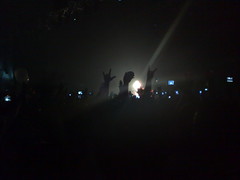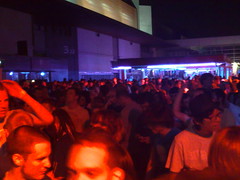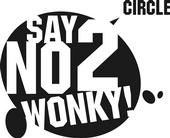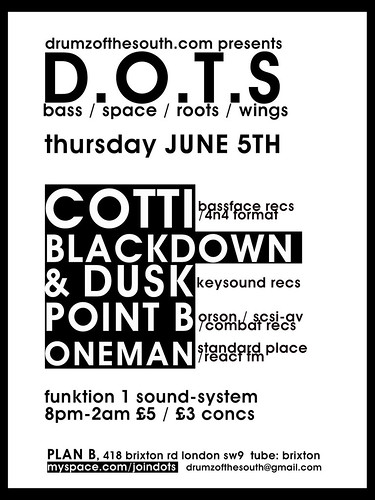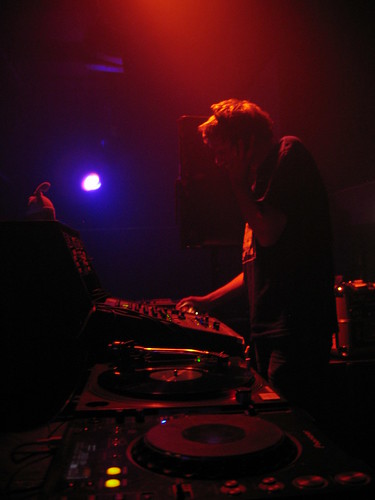 Recently I interviewed Appleblim for the Dubstep Allstars 6 CD sleevenotes. Now the CD has dropped, here’s our conversations in full.Blackdown:
Recently I interviewed Appleblim for the Dubstep Allstars 6 CD sleevenotes. Now the CD has dropped, here’s our conversations in full.Blackdown: So can you tell me a bit about your musical background?
Appleblim: “I am not originally a Bristolian, I came from Notts and Plymouth before I moved to London in ’94, was there 8 years playing bass in a math-rock / psych band, going to Metalheadz, Jungle Fever, Movement and all the major techno nights like Final Frontier, Bloodsugar as my mates set up a d&b label and played on pirates etc, then 3 years in Bath studying music technology, which is when I discovered the FWD>> scene, then after that started supporting Pinchs early Context & Subloaded dubstep nights, and finally moved to Bristol after the course in ’06.”
A: “Basically moving to London in ‘94 was ‘the one’ really. I’d been going to raves but never really thought of being a DJ. But when me and my mate moved to London we just caught the bug, listening to the radio, of what was going on, picking up our first jungle tunes and stuff. It was actually my friend that got me into DJing: he came into some money and bought some decks. But I taught him to mix because he wasn’t a particularly rhythmic bloke.”
“So I learnt with his records: Moving Shadow, Reinforced, Omni Trio kind of stuff. So I’ve always been around it but didn’t take DJing seriously until Sarah asked me to play at FWD>>. I’d had a few gigs before that, just from putting on a few nights on in Bath where I was at the time – that’s actually how I met Pinch, Blazey and Peverelist. They came over and played basically. Pinch gave me my first gig actually, just in a little room at a drum & bass night, but when Sarah said I should do a warm up at FWD>> it was a bit ‘whoah,’ a reality check.”
B: How had she heard you DJ?
A: “Just from stuff she’d heard me play in the office and generally pushing, stuff I was listening to that she enjoyed. I’d done a little cover on Rinse as well. She was like ‘you should play down at the club’ and it was bonkers really. I’ve had a really steep learning curve. Playing at your favourite club was a bit much. I was never nervous and I wasn’t technically that good at the time. It’s been a bit of trial by fire: chucked in and learning in front of people. It’s been a bit harrowing a few times but it’s sharpened me up. Going from just ‘doing it’ to thinking about how you want to shape your sets – it’s made me think differently about the whole thing. I’ve always enjoyed listening to DJs who took you on a journey, but I’d never really thought about how they did it. It was really good fun to do it myself, doing the warm up slots gave me the freedom to mess around a bit more, y’know?”
B: But didn’t you play at the Skull Disco parties in Stoke Newington?
A: “Yeah but then again it was more just like I wouldn’t have said they were good sets. I wouldn’t have said they were good sets, just more of an opportunity to hear the music more. And to hear Shackleton’s music more: and his music wasn’t being heard many places. So it was a place to hear that stuff loud. But that was playing recently bought tunes for the fun of it. I’ve been chasing producers around for new music since I very first discovered FWD>> and I gradually ended up getting given a few things: it’s a real addiction. Some DJs have the strength of their mixing talents to see them through.”
B: Despite all the stress, it must have been fun playing FWD>> though?
A: “Yeah it’s my favourite room in the world.”
B: Yeah it’s my favourite room too, that space between the pillar and the decks.
A: “There’s been so many moments. It’s very strange going from being a raver who was there obsessively down the front to going to someone standing behind the decks. It’s definitely an honour: I’ve had countless epiphanies down there, so if I can give people a few of those then that’s my job done.”
B: I remember coming down to see you early in 2007 and leaving feeling you’d really discovered your ‘sound’ as a DJ...
A: “Yeah I remember and was really proud of that because before I’d felt that I’d either tried to fit too many or the wrong style into my sets. But I made a conscious decision, and Sarah [from Ammunition/FWD>>/Tempa] had told me this too, to stick to my guns. Sarah had said that’s why she’d asked me to play there. Not that it’s ‘don’t play to the crowd’ but you’re here because you have a certain selection and taste. And I was like, yeah I should just keep drawing for the things I like listening to, because if you lose a bit of the floor, gradually you’ll get it back again."
B: Do you think you need to be stubborn as a DJ?
A: “It’s that age old thing: do you want to be a party DJ or do you want to be someone who carves something a bit new? But playing down there is so different to someone who’s employed in a bar to keep people drinking, you have carte blanche. So even if there’s only ten blokes down the front going ‘oi speed it up will ya, we want ‘dubstep!’ sod it, the boss has told me I can play what I want so I will. Take risks. Even Hatcha playing the Mystikz. I remember the first few times he did and I was confused and I stood still for a bit. I remember Youngsta playing breaky or early grime but then to hear this weird odd offkilter stuff... it was weird but then look at what it did. But you’ve got to be brave like that, definitely.”
B: So is this CD ‘about’ your sets at FWD>>?
A: “Yeah, pretty much. I guess being given the opportunity to go to other places shapes what you do and how you want to approach selecting tunes but FWD>> is the one for me so if something works there then that’s what I’m happy with, y’know?”
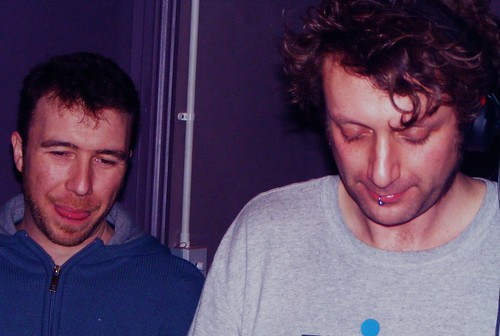 B:
B: So tell me how things have evolved with Shackleton? You were first best known together with Skull Disco but now have both developed unique but different styles.
A: “Shackleton was never from a dance music background, whereas I was. I’ve been into it since I was a little kid. For Shackleton DJing was never part of it and he was always not every confident, and in terms of finding tunes and playing them to people that’s not something that was ever going to be a buzz for him. He is about making his own rhythms and trying them out. It’s a completely different way of looking at things. So it makes sense that we’ve drifted our own ways. But the stuff he’s doing with his live set is incredible, I’m so pleased to see him go from struggling to do things on turntables because that’s the way we’d seen it done – you go cut your tunes and you play them – but he’s just taken it on somewhere else completely. Every time I see him it’s mad, I see it taken on a step further, becoming just totally himself. Really incredible, y’know?”
B: While his music is quite technical to mix, you both share a love of bass and percussion: is there no way you could try to find room in your sets?
A: “I think for that reason I was always quite scared of playing Shack’s stuff, because of the percussive nature of it: if you’re not confident as a DJ it’s hard to pull that off. But I think we have got really different ways of looking at music and while we have a lot of shared tastes we have things we probably don’t understand about each other’s way of looking at things. And Shack is single minded like that, y’know? Which is brilliant because I think that comes through in his music. Whereas for me I’m not a creator in the same kind of way. I’m more the person who used to carry tapes and records around to people’s houses, being the one sat next to the stereo going ‘oi, check this out!’ That’s what I feel like I’m still doing now. So it’s kind of a different thing but nice we’re still in touch and the whole Skull Disco venture has got a long way to go in lots of weird different directions. It’s great to be involved.”
B: In many ways you’re central to the faction that has pioneered this dubstep/dubby techno axis. Tell me about the trip to Berlin...
A: “That was an amazing trip, in the early days of us getting any bookings anywhere. One of the things that Shack and I had bonded over, in terms of what we listened to, was all the Burial Mix stuff. So getting booked to play Berlin it was like, of course we’re going to go to Hardwax and Dubplates and Mastering, as places we’d heard about for so many years. I’d been a big fan of the whole Chain Reaction sound since working in a record shop in ‘97. So we went and cut some dubs at Dubplates and Mastering and met the people who run the shop and it’s just completely fascinating, as these are the dudes who were the first to set up a dance music shop in Germany. There’s a lineage there.”
A: “But it was funny because they don’t keep posters up outside the shop, in fact they’re quite militant about taking them down, but they left up this huge one that had a photo of Shackleton raving at Subloaded with his arms in the air and another weird one of me. I think it’s still there now. They love Shackleton, it was a real buzz. I got to meet all of them, they treated us like family. We didn’t realise they’d been such fans since the first one: you put the records out and you don’t think about where they’re getting to. But they’d been really interested, so to meet those people and know they were into our music is bonkers really.”
B: And then you took it a step further with the T++ connection...
A: “It was literally through that meeting and that I’d been chatting to one of them, Torsten, online before, to do with stocking our records, and I said to him oh can you get me the details of T++ and he said, ‘oh you do realise this is me?’ And it’s like oh, you were Resilent, Erosion and Various Artists and all these things that I absolutely used to love. It was wicked and mad to think that the music in England makes waves over there in the same way that it was making waves back then for us. They’re as obsessive and fascinated by the whole dubstep thing. He sent us music, we struck up a friendship and did a real nice job on the Shackleton remix. His remix of “Vansan” isn’t going to come out on Skull Disco so I’m definitely thinking about it for Applepips and there’s this really nice techno basically thing he sent us – most of the stuff he sends isn’t as he’s moved into this really strange breaky chopped up stuff – but there’s this one thing that is the straightest thing he’s done in a while and I absolutely love it. But it’s a case of the label being established before I approach too much. Once the new release is in the shops I’ll feel more confident but it’s definitely something I want to do.”
B: I like the idea of you taking Bristol dubstep and Berlin dubby techno and exploring the space between the two and finding something that’s neither.
A: “I love the shared area between them and I’ve decided that ‘Pips is going to explore any one of them. Hopefully people will know that it’s going to be just, good interesting music rather than one particular genre. Because you find that people are listening to all this other stuff even if they’re making techno, so let’s bring it all together.”
B: The mix nails the state of the dubby techno/dubstep sound really well. But I have two concerns with this interesting direction. One is that it will just become 140 bpm techno, with little elements left from the dubstep side of things, like an edge or bass or swing or odd rhythms. Also it's a fine line between having a little dubbed out breathing space and totally clean formless e-lead headspace, where you move from the London/Jamaican-influenced dub to empty anodyne techy headspace. The edge, the rudeness of the bass could get lost. Do you think either of these concerns are valid?
A: “Completely. For me, it’s about the swing. Now, you may say that some of the tunes on this mix are essentially halfstep, like ‘Harajuku’ or ‘Moog Dub’ , even ‘Circling’, but I fell anything I play with that kind of halfstep feel must always have a swing or funk to the rhythms around the main kick and snare…for example, ‘Lean Forward’ - one of my all time favourite tunes, regardless of genre’ -essentially has that halfstep kick and snare pattern but there is so much funk and swing going on around that in the percussion etc that you don’t even really notice…”
A: “I think there’s a lot of genre blurring going on, and like you say its sort of a danger that it will become 140 bpm techno, but the answer is exactly what you have said, it needs to retain some funk and swing. Having said that I try to just view great music as great music, and always have, so that I might play a tune by a ‘dubstep’ producer that sounds essentially like a ‘techno’ tune… in the end, if it moves you it moves you… also there is so much funk in say, the hi hats and rhythms of Derrick May, whilst some boring techno can be very straight and unfunky… there is always those that have the funk and those that don’t in any scene!”
B: How did you go about approaching the mix, in terms of how you wanted the direction of it to go?
A: “I wanted the mix to be a representation of what I play in the clubs, a mixture of unreleased exclusive dubplates and some big tunes that I helped to break, things like RSD’s pretty bright lights, Peverelist’s ‘Infinity is now’, and Martyn’s remix of Broken Hearts. I was amongst the first to play these tunes out, and wanted to give more exposure to tracks that I really think are phenomenal.”
A: “I like to build a set, not always start with bangers, I like to create an atmosphere, obviously it’s a bit of a cliché to start mellow and work upwards but I find it works for me, the harder tracks have much more impact if you have played some spacey-er, deeper, more ‘head’ music first. So this is what I tried to do with the mix, moving through spacious dubby tracks like ‘Gather’, ‘Circling’ and ‘Moog Dub’, then heading into reggae drops and 4x4 techy stuff with ‘Babylon’ ‘Bad Apple’ and ‘Percession.’”
B: The mix is hung on two real emotional peaks for me, sticking out almost like the pillars of a suspension bridge: early on with Pinch’s “Get Up” and later Martyn’s “Broken Hearts remix”. How did you go about ordering the tracks?
A: “I wanted to include get up as I personally love the song, and it is a SONG rather than a track and I think that’s very important for this scene, it’s the same with ‘Reminissin’ by Geiom… these are two tunes that always make me sing along and give me a shiver down the spine. The same with ‘Broken Hearts’, for me it’s a real emotional track so I wanted to give something like that towards the end of the mix to show that its not just all about taking it harder and more banging.”
Dubstep Allstars 6 mixed by Appleblim is out nowPS who knows the story of how Appleblim got his DJ name? My lips (sic) are sealed. Hehehe…





